|
WC vs. History: Don't Give Up The Ship! Fight Her Till She Sinks.
Today marks the 205th anniversary of the Chesapeake-Leopard Affair of 1807. An event that greatly angered Americans and was one of the many factors that led to the declaration of war against the British in June 1812. Today’s WC vs. History focuses on the first of the ships involved, the USS Chesapeake and its story and spot in Wing Commander lore.
The War of 1812 began on 18 June 1812 when the United States declared war on England for a number of reasons including impressment of American sailors and interfering with American free trade with France. This month marks the start of bicentennial anniversaries for the war’s many engagements. Wing Commander has only one direct reference to the conflict, besides several ship names, and it comes from Admiral Tolwyn in Fleet Action:
"There was an ancient cautionary tale told in the service academies, the incident dating back to a war once fought between England and America. In an encounter between an American and British ship the commanding officer of the American vessel was mortally wounded, and the junior officer took him down below deck to the surgeon. In the short interval that followed all the other officers were hit and, without his even being aware of it, the junior officer was now in command. By the time he returned to the deck his ship had already been battered into submission and forced to surrender after barely putting up a fight. The junior officer was held responsible, court-martialled, and found guilty of dereliction of duty, a duty he was not even aware had suddenly come to rest upon his shoulders. The lesson was part of the tradition and backbone of the fleet - there is no excuse for defeat."
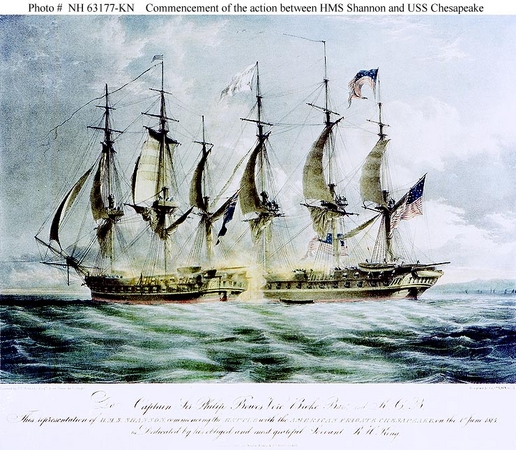
The battle Tolwyn was referencing was between the USS Chesapeake and HMS Shannon on 1 June 1813, 20 miles off Boston, Massachusetts. USS Chesapeake was one of the six frigates ordered by the Naval Act of 1794. These were the original six warships of the United States Navy. What made the Americans frigates effective was there speed and firepower. Armed with 38 guns, the frigates could engage most ships with an advantage. Those ships or battles it could not win through firepower, it could flee with its greater speed. The story of the USS Constitution fleeing a British squadron, through the use of rowboats in front and dropping out the anchor and reeling it in, is one of the most impressive escapes in naval history. Chesapeake was to have a less illustrious history.
The Chesapeake began her naval career in the Quasi-War with France and the Barbary Wars, the United States first post-Revolution military actions. The name Chesapeake was first to gain notoriety and infamy in 1807. The Chesapeake-Leopard Affair was one of the many impressments events that angered the American public and became one of the reasons for the declaration of war in 1812.
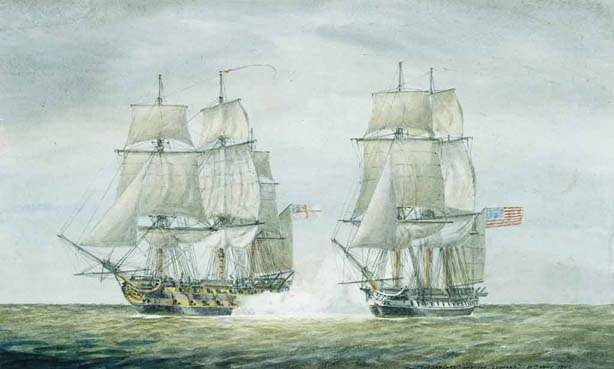 The Chesapeake-Leopard Affair, June 1807
The Chesapeake-Leopard Affair, June 1807
On 22 June 1807 HMS Leopard, sailing in American waters off the coast of Norfolk, Virginia, signaled to USS Chesapeake as she made her way out of port. Originally signaling that she wished to exchange dispatches, when the British officer came aboard the Chesapeake he carried written orders that the ship was to be searched for deserters. Commodore James Barron of the Chesapeake refused and the British officer returned to his ship. A shot was fired across the bow of the Chesapeake, followed by broadsides for fifteen minutes. Chesapeake was able to fire a single broadside in response because she was completely unprepared for battle. Commodore Barron struck his colors. Three of his crew was dead and eighteen were wounded, including the commodore himself. The British boarded and took four crewmen away. Barron had even offered the ship as a prize of war! The British, thankfully or unthankfully depending on how we think about it, declined his offer. The American public was deeply upset by the quick surrender of the Chesapeake. President Jefferson remarked, "Never since the Battle of Lexington have I seen this country in such a state of exasperation as at present, and even that did not produce such unanimity." Barron was later court-martialled and removed from service for five years. He later returned to service in the Navy, with a bit of controversy amongst his fellow sailors. In 1820, he fought a duel with Commodore Stephen Decatur, killing Decatur and suffering a serious wound himself, over the 1807 action. Decatur had served on the court martial that had punished Barron.
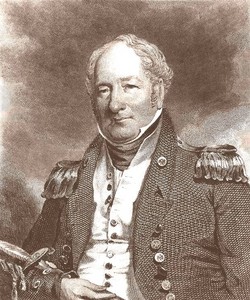
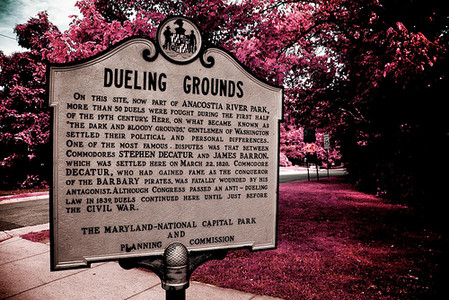
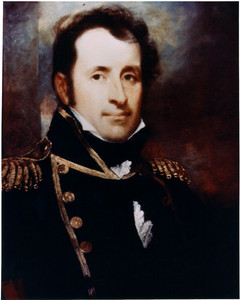 Commodores Barron and Decatur fought their famous duel at this site in Maryland in 1820.
Commodores Barron and Decatur fought their famous duel at this site in Maryland in 1820.
After the declaration of war against England in June 1812, the Chesapeake conducted one war patrol. She captured five British ships before returning to port. On 20 May 1813, Captain James Lawrence took command of the USS Chesapeake after the previous captain resigned over poor health. Two weeks after taking command, Lawrence sailed out to meet HMS Shannon, under Captain Broke, who was blockading Boston Harbor. Captain Broke was relentless in gunnery drills, conducting three hours worth every day. His men were marksmen with their weapons. Broke wanted to engage one of America’s new frigates that had already scored so many victories against his Majesty’s Navy. He attempted several methods of calling on the Chesapeake to come do battle, including finally sending a written note directly to Captain Lawrence:
"As the Chesapeake appears now ready for sea, I request you will do me the favour to meet the Shannon with her, ship to ship, to try the fortune of our respective flags. The Shannon mounts twenty-four guns upon her broadside and one light boat-gun; 18 pounders upon her main deck, and 32-pounder carronades upon her quarter-deck and forecastle; and is manned with a complement of 300 men and boys, beside thirty seamen, boys, and passengers, who were taken out of recaptured vessels lately. I entreat you, sir, not to imagine that I am urged by mere personal vanity to the wish of meeting the Chesapeake, or that I depend only upon your personal ambition for your acceding to this invitation. We have both noble motives. You will feel it as a compliment if I say that the result of our meeting may be the most grateful service I can render to my country; and I doubt not that you, equally confident of success, will feel convinced that it is only by repeated triumphs in even combats that your little navy can now hope to console your country for the loss of that trade it can no longer protect. Favour me with a speedy reply. We are short of provisions and water, and cannot stay long here."
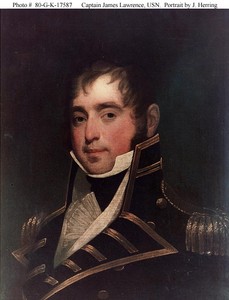
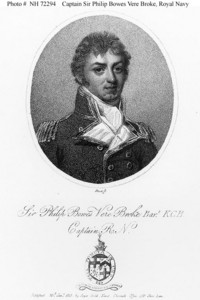 Captains James Lawrence and Philip Broke
Captains James Lawrence and Philip Broke
The message actually missed Lawrence because he had sailed to meet the Shannon before it could be delivered. At 6 pm on 1 June 1812 the two ships joined battle and began to exchange shots. Shannon was able to get the better of the Chesapeake because of her well trained gun crews. One of the shots Shannon fired destroyed the Chesapeake’s wheel leaving it unable to maneuver. The Chesapeake was raked by the Shannon by several broadsides. Captain Broke then closed with the Chesapeake and ordered a boarding action. Captain Lawrence did the same for the Americans, but the bugler of the Chesapeake did not sound the call and only those within earshot of Lawrence heard the order. Almost immediately after, Captain Lawrence was mortally wounded and taken below decks. As he was taken below he uttered his last orders to his officers, “Don’t give up the ship. Fight her till she sinks.” The Americans prepared to repel the British, however they were defeated in roughly ten minutes by Captain Broke’s boarding party.
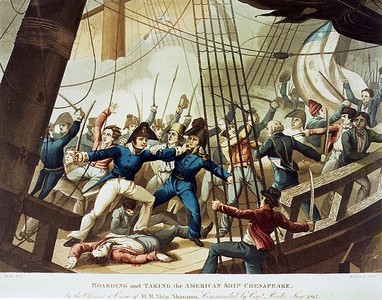
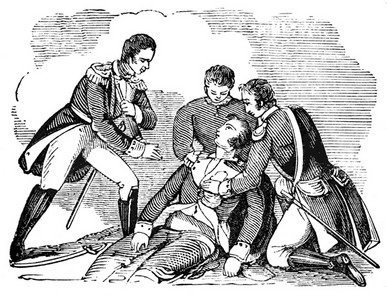 The boarding of the Chesapeake led by Captain Broke and the mortally injured Captain Lawrence below decks with his officers.
The boarding of the Chesapeake led by Captain Broke and the mortally injured Captain Lawrence below decks with his officers.
Below deck, Captain Lawrence lay wounded with Third Lieutenant William Sitgreaves Cox, a gun crew chief. While he helped tend to his captain, he unknowingly became the senior non-wounded officer as the others were killed or wounded and thereby the commanding officer. The ship surrendered while he was completely unaware that he was in command. In 1814, he was court martialed for dereliction of duty for leaving his battle station while under fire, despite tending to his now martyred captain. After more than two decades of campaigning by Cox’s great-grandson, in 1952 President Truman signed a Resolution of Congress that cleared Cox’s name and restored his rank.
Captain Lawrence’s final orders soon became a rallying cry for the US Navy. Commodore Oliver Hazard Perry, a friend of Lawrence, named his flagship USS Lawrence. He created a new battle flag to honor his friend as well. It flew during the Battle of Lake Erie 10 September 1813 when Perry’s forces defeated the British and made his own way into history with his famous note, “We have met the enemy and they are ours.”
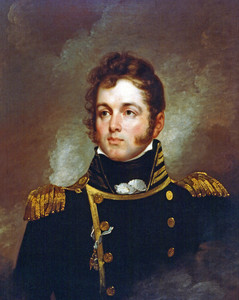
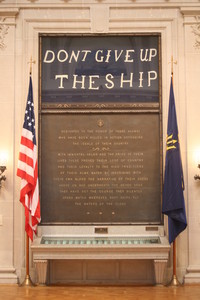 Commodore Perry and his battle flag.
Commodore Perry and his battle flag.
|

